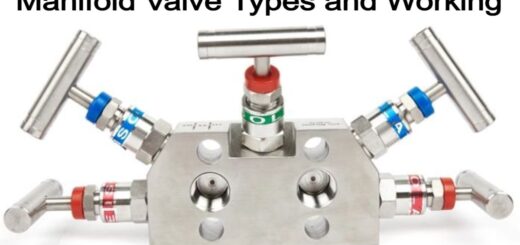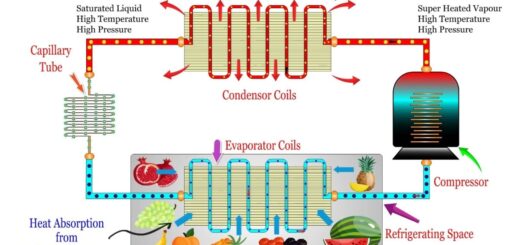Refrigeration System Working

Refrigeration System Working
Refrigerators are used in businesses and homes for one reason: to keep food cold. Fridges are vital because they keep food fresh for longer periods of time, reducing food waste in both homes and businesses. They also help companies raise income by preserving food quality for longer periods of time and giving chefs the time and opportunity to make their best dishes.
The World Refrigeration Day was founded in 2019 with the aim of raising awareness of the importance of HVAC-R in society among the international community. For millennia, mankind relied solely on nature to provide ice.
From the underground food and beverage storage structures built out of terracotta rings by Chinese Emperor Shih Huang Ti (220 B.C.) to the ice farms along the Hudson River in the mid-nineteenth century, the development of refrigeration technology was hampered by the lack of natural ice during the winter months (Gantz, 2015).
Introduction: (Refrigeration System Working)
Refrigeration systems in the chemical industry are often made up of standard equipment that can be used in a variety of industries. Due to factors such as temperature range requirements, capacity needs, fluctuating loads, dangerous locations, and the presence of corrosive chemicals, the chemical industry requires design and efficiency that differs from commercial facilities.
The systems are typically designed by experts, with process engineers providing design requirements.
A few Basic Definitions of Refrigeration systems
1. Heat is a form of energy that is transmitted as a result of a temperature difference. To a greater or lesser extent, heat occurs everywhere. It cannot be formed or destroyed as a source of energy, though it can be transformed from one form of energy to another. It’s important to note that heat energy only moves in one direction: from a warmer object, material, or region to a cooler one.
2. The absence of heat in an object, liquid, or region is referred to as cold. No method has yet been devised to achieve “absolute zero,” the state in which all heat has been extracted from any entity, material, or region, according to another concept. On a Fahrenheit thermometer scale, this zero point will be 459.69 degrees below zero or 273.16 degrees below zero on a Celsius thermometer scale.
3. Refrigeration, also known as cooling, is the process of removing excess heat from one object, material, or space and transferring it to another. The temperature may be lowered by using ice, snow, chilled water, or mechanical refrigeration to remove heat.
4. The use of mechanical components arranged in a “refrigeration device” for the purpose of transmitting heat is known as mechanical refrigeration.
5. Refrigerants are chemical compounds that are compacted and condensed into a fluid and permitted to develop into a vapor or gas as they cycle through the mechanical refrigeration system.
The refrigeration cycle is based on the well-known physical theory that heat is extracted from the surrounding material or area when a liquid expands into a gas. (You should put this idea to the test by wetting your finger and keeping it up to the light.) It quickly becomes cooler than the others, particularly when exposed to any air movement.
That’s because the liquid in which you dipped it is evaporating, extracting heat from the skin of the finger and the air around it as it does so).
Refrigeration Stages (Refrigeration System Working)
Many implementations have successfully used refrigeration systems with one, two, three, or four stages of compression. The number of refrigeration levels is determined by the number of compression stages required, the economics, and the form of compression. The phases are depicted in the parts that follow.
One-Stage Methodology
A typical one-stage refrigeration device for pure propane refrigerant is shown below. It depicts a single-level chiller in use and the cooling curve that goes with it.
Two-stage Methodology
A two-stage refrigeration device with an inter stage flash economizer is typically used to save money. Process heat can be removed at the inter stage level rather than at the low stage level to save even more money.
Three-Stage Methodology
Flash economization and an intermediate heat source can be used in the same way as in a two-stage system. Even if the savings aren’t as evident as with a two-stage system versus a one-stage, they can still be important enough to warrant the extra equipment.
If the number of stages is increased, energy consumption can be reduced.
Refrigeration device construction costs rise as the number of stages rises, and the best total cost is calculated by the particular system, which is chosen based on a collection of economic criteria. Refrigeration compression horsepower can be decreased even further by transferring refrigerant load from cooler to warmer temperatures.
With 25°F propane, the gas is first cooled to 30°F, then to 35°F with 40°F propane. The temperature of 25°F was chosen. With 25°F propane, the gas is first cooled to 30°F, then to 35°F with 40°F propane. The 25°F level was chosen because the compression ratios for each stage were identical. Equipment or process conditions may control the inter stage pressure and corresponding refrigerant temperature.
How a Refrigeration System Works
The vast majority of refrigerators operate on the vapor compression principle. Compressor, condenser, expansion unit, and evaporator are the four essential components of a modern refrigeration system. A volatile fluid (refrigerant fluid) circulates through the refrigeration system, where it is converted into liquid and vapor forms on a regular basis.
Compressing superheated vapor from low pressure (evaporating pressure) to high pressure is the job of the compressor (condensation pressure). After that, the high-pressure, high-temperature refrigeration fluid flows into the condenser.
Mechanical elements in a conventional refrigerator make it simple to reach and maintain cold temperatures. They are the parts that keep the refrigeration cycle running. To achieve the desired results, these components are highly specialized. A compressor, condenser, expansion valve/metering or throttling unit, and evaporator are among them. In addition, the fridge must use a refrigerant, which is a fluid that provides cooling. All of these components need the refrigerant to move through them, and the refrigerant must be altered in each to achieve the required temperatures.
Refrigeration System Components
Compressor
Its work is to control a motor and a pump to regulate the flow of refrigerants. It will then pressurize the refrigerant and reduce its volume as a result.
In both industrial and domestic refrigerators, there are five different types of compressors. Reciprocal, rotary, pin, centrifugal, and scroll are some of them. The reciprocating compressor is the most common form of compressor used in both home and commercial kitchen refrigerators.
Condenser
The refrigerant is condensed by the condenser. The refrigerant is then cooled by converting it to a liquid state in the condenser.
Condensers are divided into three categories.
at home. They’re perfect for small amounts of refrigerant. Since it has aluminum or copper coils at the back of the fridge, the air-cooled condenser is also known as a coil condenser. The coils increase the refrigerant’s surface area for cooling.
There are two types of air-cooled condensers. The natural convection condenser is a device that uses the natural flow of air to condense liquids.
Air-cooled. There are two types of air-cooled condensers. The forced convection condenser uses a fan to draw in cold air, and the natural convection condenser uses the natural flow of air to cool the refrigerant.
Condensers that are cooled by water. In big plants with a lot of refrigerants, these are used. The cooling effect on the refrigerant is provided by water. Water-cooled refrigerants are classified into three categories.
Water- cooled condensers. Water-cooled systems that are tube-in-tube or double pipe type Shell and coil type Shell and tube type Water-cooled systems that are tube-in-tube or double pipe type Water-cooled systems that are tube-in-tube.
Evaporative Condensers are a form of the evaporative condenser. These are a mixture of water-cooled and air-cooled compressors used in ice plants.
Evaporative Condensers are a form of the evaporative condenser. These are a mixture of water-cooled and air-cooled condensers used in ice plants. As a result, they have advantages over all forms of condensers.
Evaporator
Inside the refrigerator, the evaporator absorbs heat. It serves as a heat transfer medium between the stored goods (load) and the refrigerant. The evaporator is usually the coldest component of the fridge or freezer. The refrigerant is cold and travels at a slower rate to absorb as much heat from the load as possible. It heats up and transforms into a gas as it absorbs the sun. More heat is drained from the load as the refrigerant is vaporized. The refrigerant is then forced back into the pump, now hot and gaseous.
Refrigeration Models (Refrigeration System Working)
Refrigeration heat loads are linked to compressor power in refrigeration system models. The refrigeration models’ compressor sections use the same basic equations as the compressor models discussed previously. Refrigeration systems should use the proper composition, and any makeup gas would have a component mixture.
The overall refrigeration loads are determined using the estimated compressor suction flows and the heat exchange duties calculated by the individual unit models. The enthalpy difference between each refrigerant level is used to measure the refrigerant vapor flows produced by these loads. Compressor discharge is predicted using exchanger models of refrigerant condensers.
Power grid cooling systems based on high-temperature superconducting connectors
Refrigeration system Thermodynamics
Refrigeration systems work by repeating a series of thermodynamic processes to return the working material to its original state. A thermodynamic refrigeration cycle (refrigeration) extracts heat from a low-temperature object and rejects it at a higher temperature. This cyclic method necessitates work feedback in order to avoid violating the second law of thermodynamics.
The reversible Carnot cycle is the foundation of the ideal refrigeration device. The Carnot cycle is a theoretical term since it is ideal, meaning it is lossless, frictionless, and heat exchange processes have no temperature variations. None of these ideas will ever be realized.
The reversible Carnot cycle is the foundation of the ideal refrigeration device. The Carnot cycle is a theoretical term since it is ideal, meaning it is lossless, frictionless, and heat exchange processes have no temperature variations. In fact, none of these ideals will ever be realized. As a result, the Carnot cycle serves as a benchmark to which the output of all other refrigeration cycles can be measured.
Understanding the Refrigeration System
The refrigeration cycle entails the transfer of refrigerant from one location to another and in various ways, with the ultimate aim of lowering temperatures in a cabinet, counter, or cold space. One of the most important reasons to learn how your commercial refrigerator operates is so that you can easily clean and repair it.
Understanding that your refrigerator uses an air-cooled condenser, for example, can assist you in locating the best location for your appliance to make its job easier and reduce energy usage. Only by grasping the fundamentals would one be able to get the most out of their commercial refrigeration. (Refrigeration System Working)






